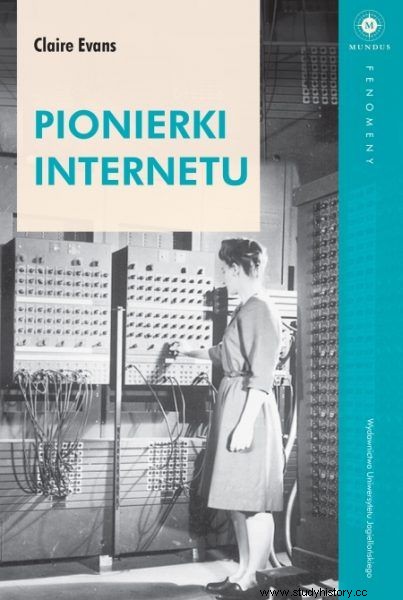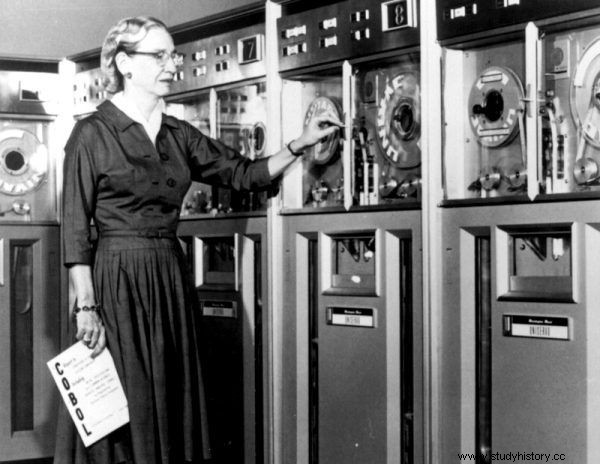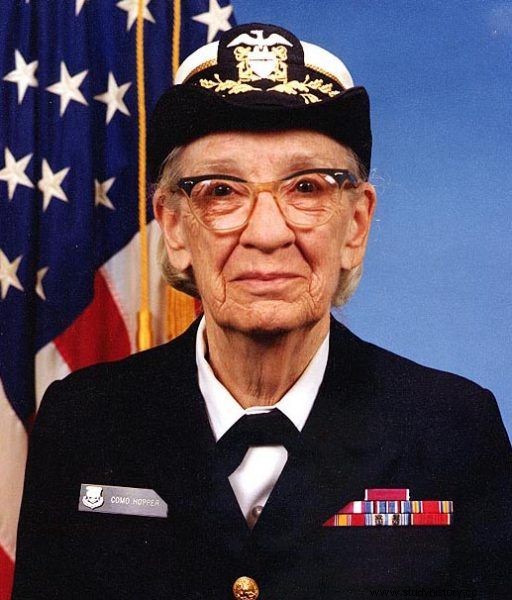Computer pioneer, Rear Admiral in the United States Navy, the first female PhD from Yale University. She revolutionized programming and spread the word "bug" in the computer science vocabulary.
The Mark I looked more like Charles Babbage's mechanical machines than computers in the modern sense of the word - inside its steel case, a rotating propeller shaft powered by a four-horsepower motor actuated a sequence of transmissions and timers that ran along the length of the device. Code for Mark I was written by hand in pencil on standardized coding paper and then it was transferred - literally by knocking out - onto spools of three-inch-wide tape resembling ribbons for pianos or perforated cards for Jacquard's looms.
Tame the beast in a week
The locations of the holes on the tape using a unique eight-bit code corresponded to the digits, processes and applications of the given calculation. Although the Mark I was programmable in the sense that it would accept these rolls of punched tape, the distinction between hardware and software was fuzzy at the time, if not there - each calculation involved flipping switches and rewiring the cables.

The article is an excerpt from the book Pioneers of the Internet which has just been released on the market
Howard Aiken introduced Grace to the rest of the crew, two naval second lieutenants who had come to Harvard while she was still at Cadet School. Later she found out that one was bribing the other to get away from sitting next to the new recruit - "they were convinced that the old gray-haired teacher was coming and neither of them wanted to occupy the next desk" . Aiken gave her a codebook, a few pages of incomprehensible commands, and an assignment:Write a program for Mark I that would compute the interpolation coefficients for the arctangent to twenty-three decimal places. "And then he said I had a week for it," she said, "a week to learn how to program this beast and run the program" . The task itself wasn't particularly difficult for Grace - she had a PhD in mathematics. The machine was incomprehensible to her. She had no instructions, no precedent to use as the Mark I was the first of its kind. Grace could do many things, but she lacked the engineering background and couldn't tell switches from relays. Aiken was checking her out.
"Wired" boss
Being self-taught by nature, she took up this challenge. She pored over the codebook and questioned two second lieutenants, mostly twenty-three-year-old Richard Bloch, a Harvard freshman and math specialist who would become her closest associate. There were also IBM engineers hanging around the lab, fixing the faults - from them she also extracted all possible information. She sat late into the night trying to find out about the construction of the machine by studying the plan and wiring diagrams of Mark I. She sometimes slept at her desk . Years later, when Grace was already a famous figure in the new field of computer programming, she always gave the most difficult tasks to the youngest and least experienced team members. She concluded that they did not yet know what was impossible.
During her first year at Harvard, she worked non-stop, and as new programmers joined the team, Grace continued to pursue military ranks. With the same diligence and ingenuity she brought to teaching students, she became an invaluable member of the team. A gray-haired teacher from upstate New York has met eminent mathematicians, engineers and virtually everyone in the microscopic world of computer science. "It was fascinating," she said, "a breeding ground for ideas, concepts, dreams and everything under the sun." So great was the computation demand that Aiken designed a second computer, the Mark II. Grace learned it as well.
Like his machines, the Aiken itself lacked a manual. He was explosive, touchy and obsessed with details. He was very proud to lead a team working on his own invention. Although the Mark I was built by IBM and tucked away in the basement of a prestigious university, Aiken cared for him as if he ran a naval facility. He was strict with discipline. All subordinates were to come to work in full uniform and call him "lieutenant commander". The female computer was referred to as the naval ship. Aiken tormented people with work - when he made a mistake, he would "roar" at the culprit.

Grace Hopper in 1952
The criticism was so vehement and fierce that Grace often went into trouble-shooting after hours for peace and quiet. But she has learned to see her boss as a kind of machine. "It's wired that way," she told Bloch, who often fell in love with his superintendent. “If anyone understood Aiken and the way it is wired, it was great to work with him. I didn't have any difficulties. But if someone tried to tell him what to do, God alone could save him. " Aiken's approach to the military hierarchy was difficult, but in the end it turned out to be good for Grace - treatment in his Computation Lab was largely commensurate with rank and ability, not gender. Uniforms and official titles contributed to the disappearance of traditional social roles, as did the complete isolation of the laboratory from the outside world . And although Aiken never wanted a female officer in his ranks, he had to accept giving him Grace because he stuck to protocol. And just like Grace told Howard Aiken, he would need a woman in the lab. She was right.
Grace - "equal guy"
She eventually became Aiken's right-hand man and was soon fully responsible for Mark I. She wrote code that solved some of the most difficult math problems in the war, and even produced a manual for that computer, a detailed five-hundred-page document full of circuit diagrams and operation codes. Together with her colleague Richard Bloch, she developed an encoding and batch processing system that made the lab the most efficient data center of the time, keeping order in a grueling warfare environment that was beyond the capacity of less capable officers. And in addition to Grace's core qualifications, the presence of a woman on the team had important benefits . When Mark I had mechanical problems, Grace would sometimes "pull a mirror out of her purse, stick it in front of cams and look for sparks."
Towards the end of his professional career, Aiken gave his colleague a brief assessment, in his mouth it was the highest distinction:"Grace was an equal guest". Like the submarine, the Mark I was in the care of eight-hour shift workers around the clock, and the computer itself ran an impressive ninety-five percent of the time during the war. The demand for war calculations continued, and urgent requests reached the Computing Laboratory from all fronts of the conflict. Grace, who had always been insatiable in learning and had attended all possible activities in Vassar, got to work. Learned to translate complex oceanography, minefishing, proximity fuses and ballistic tasks into simple arithmetic steps , introducing a tightly controlled order into a disorderly, violent world.
Mark I calculations were subject to all sorts of failure:faulty code, faulty relays, and downtime signaled by ominous buzzing, chattering and shaking. To prevent this from happening, Aiken's team often worked late into the night. One evening in September 1945, a large moth flew in through an open window, attracted by the light of the machine. Soon after, Grace found her carcass, crushed by a steel armature on one of the relays. She taped them to the journal, with the words "first case of a real worm" . Just a bug or a bug, or an English bug, is a jargon term that dates back to the nineteenth century - already Thomas Edison referred to it as mechanical disturbances, "small defects and difficulties" - and Grace was famous in the laboratory for small bugs and monsters scrawled on the blackboard that messed up in the laboratory:the dragon bit holes in the punched tape and "the pixie had a long nose with which he picked up the broken circles and pushed into the tape". After the moth incident, she bought a box of plastic bedbugs in the city and set them apart for a joke behind the computer, causing a two-day panic.
During the war, the Computation Lab was isolated from several other IT projects in the world, and Grace Hopper, dealing with the daily calculations, had neither the time nor the opportunity to find out what was happening in her field. However, representatives of the discipline sometimes showed up at her place. Grace had been working at Harvard for just a few months when physicist John von Neumann came for a visit to the lab.
Von Neumann was able to move freely - he spent most of 1944 visiting various computing projects in the United States, looking for a machine powerful enough to handle a complex partial differential equation. The Mark I was the first big computer he came across , and for three months that summer he camped in the Harvard conference room, writing his assignment on a blackboard while Richard Bloch set up operations on the computer.
Grace, still new to the lab but adept at differential equations, assisted at every stage. Neither Grace nor Richard knew the application of the problem they were solving - they were only interested in it as an interesting math challenge. And von Neumann was an eccentric figure - this talkative Hungarian theorist was then as famous as his Princeton colleague Albert Einstein. As Bloch and von Neumann worked on the assignment, they ran back and forth between the conference room and the computer. The physicist shouted the numbers as Mark I spat them out, "ninety-nine times out of a hundred," as Grace admired, "with utmost accuracy - something extraordinary."

The article is an excerpt from the book Pioneers of the Internet which has just been released on the market
After three months, von Neumann took these results back to the desert town of Los Alamos, New Mexico, where he consulted the Manhattan Project. The partial differential equation turned out to be a mathematical model for the course of the implosion of an atomic bomb. Until the bombs fell on Nagasaki and Hiroshima, Grace did not know what exactly she helped calculate. Grace did not always have time to consider where the results of the calculations went and what purposes they served. The computations were constantly pouring in, and some - as was done for von Neumann - were almost unimaginably complex.
Efficient developer
To save processing time, Grace and Richard invented the coding syntax and workarounds that laid the groundwork for the way code is still written today. As early as 1944, Grace realized that by reusing scraps of code that have come to be called subroutines, she doesn't have to rewrite code for each new task. During the war it was done unofficially - coders, i.e. programmers from the team, shared their notebooks, copying the relevant fragments by hand. Eventually, this custom was formalized and future computers were already constructed with subroutine libraries, which allowed even novice programmers to benefit from packaged instruction sequences.
When Grace's code became difficult to understand, she annotated the main code, describing the context and adding equations, which made her work easier for colleagues to understand. strong> - good code is always documented.

Grace Hopper 1986 retired with rank of Rear Admiral
It was Grace's calling card, which simplified and made the art of computer programming more accessible. Even before the war, when she was teaching in Vassar, she had students write essays on math problems, because there is no point in learning math if you cannot pass it on to someone else . When she returned to the civilian world and joined the first commercial IT company, she continued to follow this logic. Grace's most enduring contribution to the emerging field of programming has been her democratization - she has sought programming advances that will radically change the way people communicate with computers. With its help, they won't need advanced math terms, or even ones and zeros. They only need words.
The article is an excerpt from the book Pioneers of the Internet, which has just been released on the market by the Publishing House of the Jagiellonian University.
